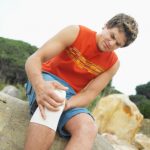 Nutritionists and other healthcare professionals have been telling us for decades that “you are what you eat” and that healthy diets are critical for a long and disease-free life.
Nutritionists and other healthcare professionals have been telling us for decades that “you are what you eat” and that healthy diets are critical for a long and disease-free life.
But did you know that diets that include fruits, vegetables and protein-rich foods can also help to prevent injuries?
Advertisement
Liz Applegate, Ph.D., Director of Sports Nutrition at the University of California, Davis, recommends injury-prevention diets that are rich in protein, minerals and antioxidants. These diets should also include zinc, iron, calcium, vitamin A and vitamin C. Zinc and iron can be found in lean beef, poultry, seafood, lentils and some fortified breakfast cereals.
When recovering from an injury, our diets should also include the supplements glucosamine and chondroitin sulfate, says Applegate. If we have a joint injury, we’re at a higher risk of developing osteoarthritis, and the supplements glucosamine and chondroitin sulfate have been shown to help decrease inflammation and improve mobility. (People taking blood thinners should not take chondroitin.)
For athletes, high-carbohydrate diets are necessary for fuel, but diets with insufficient protein intake may lead to decreases in strength and possible muscle damage.
The Harvard School of Public Health says that both animal and vegetable protein probably have the same effect on our health, but it’s important to choose protein-rich foods that are also low in fat. Beans, nuts and whole grains are healthier than animal sources of protein because they are low in fat and rich in fibre, vitamins and minerals.
According to the CDC (Centers for Disease Control & Prevention), proteins are part of every cell, tissue, and organ in our bodies and are constantly being broken down and replaced.
Protein is found in meats, poultry, fish, legumes (such as dry beans and peas), nuts and seeds, eggs, grains, tofu, milk and milk products and in some fruits and vegetables.
Amino acids are the molecular building blocks of proteins, and nine amino acids are considered to be “essential” or “indispensable.” Animal protein contains all nine essential amino acids, whereas individual fruits and vegetables do not. However, if you eat a variety of fruits and vegetables, you will not miss out.
Body builders often take protein and amino acid supplements.
According to the Sports Injury Bulletin, diets low in calcium or iron will increase the risk of injury because without calcium and iron, our bones are weaker and our muscles tire faster. Whereas, diets containing sufficient levels of calcium and iron will help promote healthy bones that will withstand repetitive stresses and muscles that won’t fatigue too early.
“Lipid peroxidation” is a biomechanical mechanism that causes damage to muscles. Studies have shown that vitamins E and C will inhibit this process and play a role in injury prevention by acting as antioxidants that combat muscle damage caused by exercise.
Of course, sports injuries aren’t the only types of injuries a wholesome diet will prevent.
Fruits and Vegetables
Kathleen Blanchard, RN, in her article “Five Fruits and Vegetables and Diseases They Fight,” says vegetables may help to lower high blood pressure, which will prevent injury to the blood vessels and lower our risk for heart disease.
Broccoli can help fight colorectal cancer and reduce the risk of lung cancer in smokers. Along with other green vegetables, it can also protect us from losing our vision as we get older.
Cherries and cherry juice can help prevent muscle and arthritis pain, due to their powerful anti-inflammatory properties. While grapes can have an impact on cardiovascular risk.
Watermelon may improve erectile dysfunction because it contains arginine and citrulline, which are known to relax blood vessels and improve blood flow.
Advertisement
The American Cancer Society says people whose diets are rich in tomatoes, which contain lycopene, appear to have a lower risk of certain types of cancer, especially cancers of the prostate, lung and stomach.
Canada’s Food Guide says we should eat 7 to 10 servings of fruits and vegetables every day.
Related Reading: Build strong bones for healthier aging and reverse osteoporosis
